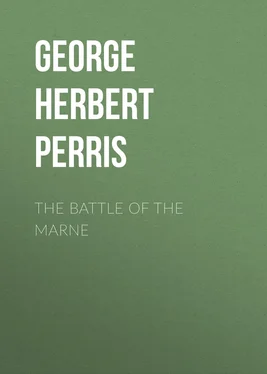George Herbert Perris - The Battle of the Marne
Здесь есть возможность читать онлайн «George Herbert Perris - The Battle of the Marne» — ознакомительный отрывок электронной книги совершенно бесплатно, а после прочтения отрывка купить полную версию. В некоторых случаях можно слушать аудио, скачать через торрент в формате fb2 и присутствует краткое содержание. Жанр: foreign_prose, foreign_antique, на английском языке. Описание произведения, (предисловие) а так же отзывы посетителей доступны на портале библиотеки ЛибКат.
- Название:The Battle of the Marne
- Автор:
- Жанр:
- Год:неизвестен
- ISBN:нет данных
- Рейтинг книги:5 / 5. Голосов: 1
-
Избранное:Добавить в избранное
- Отзывы:
-
Ваша оценка:
- 100
- 1
- 2
- 3
- 4
- 5
The Battle of the Marne: краткое содержание, описание и аннотация
Предлагаем к чтению аннотацию, описание, краткое содержание или предисловие (зависит от того, что написал сам автор книги «The Battle of the Marne»). Если вы не нашли необходимую информацию о книге — напишите в комментариях, мы постараемся отыскать её.
The Battle of the Marne — читать онлайн ознакомительный отрывок
Ниже представлен текст книги, разбитый по страницам. Система сохранения места последней прочитанной страницы, позволяет с удобством читать онлайн бесплатно книгу «The Battle of the Marne», без необходимости каждый раз заново искать на чём Вы остановились. Поставьте закладку, и сможете в любой момент перейти на страницу, на которой закончили чтение.
Интервал:
Закладка:
Field-Marshal French says: “Belgium remained a ‘dark horse’ to the last, and could never be persuaded to decide upon her attitude in the event of a general war.... We were anxious she should assist and co-operate in her own defence.” On August 21, he received a note from the Belgian Government remarking that the Belgian field army had from the commencement of hostilities “been standing by hoping for the active co-operation of the Allied Army,” but was now retreating upon Antwerp.
M. Engerand ( Le Drame de Charleroi ) says that on July 29, General Lanrezac had sent to General Joffre a report on the likelihood of an enveloping movement by the left bank of the Meuse; that after the German Chancellor’s defence, on August 4, of the violation of Belgian neutrality, the Belgian Government asked France for aid; that the French Minister of War had of his own initiative offered to send five army corps, “but, on August 5, our Councillor of Embassy at London, M. de Fleurian, informed the Belgian Minister that ‘the French Generalissimo did not intend to change his strategic plan, and only the non-co-operation of the British Army would oblige him to extend the French left.’ The Sordêt Cavalry Corps, on and after August 6, reported to the General Staff that 13 German Corps, in two armies, were intended to operate west of the Meuse, and that ten others were ready to advance on the east of the river. On August 7, Lanrezac addressed to the Grand Quartier General another report on the danger to our left; and on the 14th he expressed his conviction that there would be a strong offensive west of the Meuse directly to General Joffre, who did not credit it.”
Major Collon, French military attaché at Brussels, and afterwards attached to French Headquarters, has published the following facts in a letter to the Swiss Colonel Egli ( Temps , September 19, 1918): Although the Army of Hanover (Emmich’s Army of the Meuse) was mobilised from July 21 and concentrated in Westphalia from July 26, it was not till August 3, after the publication of the German ultimatum, that France offered Belgium her eventual military aid. This was declined; but on August 4, when the violation of the frontier occurred the offer was accepted in principle. On August 5, General Joffre authorised the Sordêt Cavalry Corps to move to the Semoy. It began its march on the 6th, and on that night Major Collon arrived at Belgian Headquarters with a view to assuring the co-ordination of the French and Belgian operations.
16
“This plan was at once weak and supple. It was feeble because General Joffre, who established it, ‘saw too many things,’ in the words of the Napoleonic warning.... He knew as well as any one the feebleness of his plan. It was imposed upon him. He sought at least to make it supple” (Reinach, op. cit. pp. 58–9).
In an article reviewing this volume ( Petit Parisien , June 16, 1916), M. Millerand, who became Minister of War a few days after the events in question, endorsed this opinion: The French Staff “had to foresee, did foresee, the two hypotheses—that of Belgium, certainly, but also that of Lorraine. Hence general dispositions whose suppleness did not escape weakness, a concentration for two ends.” The word “Belgium” here is ambiguous: it is clear that an attack by Western Belgium was not foreseen. The vice of the concentration was not that it faced two ends, “Belgium” and “Lorraine,” but that it essentially faced the end of a Lorraine offensive, whereas what was essentially needed was a northern defensive.
General Bonnal remarks: “The project of offensive operations conceived by Bernhardi in 1911 in case of a war with France deserved close study by us, which would probably have led to modifications in our plan of concentration while there was yet time” ( Les Conditions de la Guerre Moderne , p. 115. Paris: De Boccard. 1916).
General Palat writes: “The French concentration was vicious. Better conceived, it would have saved hundreds of thousands of our compatriots from the tortures of the invasion and occupation” ( La Revue , Dec. 1, 1917).
“The unknown quantity on the side of Belgium,” says Lt.-Col. de Thomasson, “condemned us at the outset to a waiting strategy. The idea of at once taking the offensive madly overpassed the boldest conceptions of Napoleon” (p. 54). “A well-advised command would have understood that it was folly to launch at once all its army to attack troops of the value of the Germans; that the offensive should have been made only on certain points of the front, with a sufficient numerical superiority, and for this purpose the forces must be economised; that, in brief, the beginning of hostilities could only be favourable to us on condition of a superior strategy such as was shown in the preparation for the battle of the Marne, but not in the initial plan or in the first three weeks of the war” (177–8).
17
See Hanotaux, Histoire Generale de la Guerre ; Engerand, “Lorraine–Ardennes” ( Le Correspondant , April 25, 1918); Paul H. Courrière, “La Bataille de Sarre-et-Seille” ( La Revue , Jan. 1, 1917); Gerald Campbell, Verdun to the Vosges (London: Arnold)—the author was correspondent of The Times on the Eastern frontier; Thomasson, loc. cit.
18
See Hanotaux, “La Bataille des Ardennes, Etude Tactique et Strategique” ( Revue des Deux Mondes , Feb. 15, 1917); Engerand, as above; Ernest Renauld, “Charleroi–Dinant–Neufchâteau–Virton” ( La Revue , Oct. 1916—inaccurate as regards the British Army); Malleterre, Un Peu de Lumière sur les Batailles d’Août—Septembre 1914 (Paris: Tallandier).
19
See L’Illustration , March 16, 1918: La Défense de Longwy , by P. Nicou.
20
The military history of Lille, is curious. See Lille , by General Percin (Paris: Grasset). M. Engerand, in his chapter on “The Abandonment of Lille,” says that a third of the cannon had been removed earlier in the year, but that on August 21, when General Herment took command, there remained 446 pieces with enough ammunition and 25,000 men, not counting the neighbouring Territorial divisions of General d’Amade. Though Lille had been virtually declassed on the eve of the war, General Percin, the Governor (afterwards cruelly traduced on the subject) and General Herment were anxious, and had begun preparations, to defend it. The municipal and other local authorities protested to the Government against any such effort being made; and at the last moment, on the afternoon of August 24, when the retreat from the Sambre had begun, the Minister of War ordered the abandonment of the town and the evacuation of the region. German patrols entered the city two days later, but it was only occupied at the beginning of October. It has been argued that, with Lille and Maubeuge held on their flanks, and the Scarpe, Scheldt, and Rhonelle valleys flooded, the Allied forces might have delayed the enemy long enough to permit of a definite stand on the line Amiens–La Fère–Laon–Rheims. General Berthaut rejects any such idea, and says that inundations would have required forty days.
21
French’s 1914 .
22
See La Grande Guerre sur le Front Occidental , especially vol. iv., by General Palat (Paris: Chapelot, 1918–19).
23
For details, see Hanotaux, Histoire General and L’Enigme de Charleroi (Paris, 1917); Maurice, Thomasson, Engerand, loc. cit. ; Sir John French’s Dispatches and 1914 ; Lord Ernest Hamilton, The First Seven Divisions ; La Campagne de l’Armée Belge , from official documents (Paris: Bloud et Gay, 1915); L’Action de l’Armée Belge , also official; Van der Essen, L’Invasion Allemande . For some information in this chapter and the subsequent note with regard to the British Army, I am indebted to the military authorities.
Читать дальшеИнтервал:
Закладка:
Похожие книги на «The Battle of the Marne»
Представляем Вашему вниманию похожие книги на «The Battle of the Marne» списком для выбора. Мы отобрали схожую по названию и смыслу литературу в надежде предоставить читателям больше вариантов отыскать новые, интересные, ещё непрочитанные произведения.
Обсуждение, отзывы о книге «The Battle of the Marne» и просто собственные мнения читателей. Оставьте ваши комментарии, напишите, что Вы думаете о произведении, его смысле или главных героях. Укажите что конкретно понравилось, а что нет, и почему Вы так считаете.










